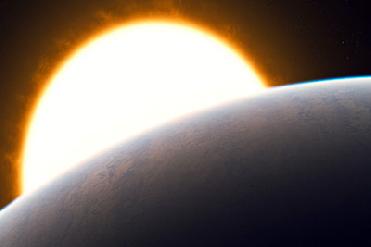
A File Photo. Credit: European Southern Observatory (ESO).
CHILE (BNS): Astronomers, with the help of Very Large Telescope (VLT), have measured a superstorm for the first time in the atmosphere of an exoplanet, the well-studied "hot Jupiter" HD209458b.
The very high-precision observations of carbon monoxide gas has also shown that it is streaming at enormous speed from the extremely hot day side to the cooler night side of the planet.
"By studying the poisonous carbon monoxide gas with great accuracy we found evidence for a super wind, blowing at a speed of 5000 to 10,000 km per hour�" Ignas Snellen, who led the team of astronomers, was quoted as saying in a news release by the European Southern Observatory (ESO).
With the help of the observations, scientists were also able to measure the orbital speed of the exoplanet itself, thus providing a direct determination of its mass.
HD209458b was the first exoplanet to be found transiting: every 3.5 days the planet moves in front of its host star, blocking a small portion of the starlight during a three-hour period. During such an event a tiny fraction of the starlight filters through the planet�s atmosphere, leaving an imprint.
A team of astronomers from the Leiden University, the Netherlands Institute for Space Research (SRON), and MIT in the United States, have used ESO�s Very Large Telescope and its powerful CRIRES spectrograph to detect and analyse these faint fingerprints, observing the planet for about five hours, as it passed in front of its star.
"CRIRES is the only instrument in the world that can deliver spectra that are sharp enough to determine the position of the carbon monoxide lines at a precision of 1 part in 100 000. This high precision allows us to measure the velocity of the carbon monoxide gas for the first time using the Doppler Effect," said another team member Remco de Kok.
HD209458b is an exoplanet of about 60% the mass of Jupiter orbiting a solar-like star located 150 light-years from Earth towards the constellation of Pegasus (the Winged Horse).
Circling at a distance of only one twentieth the Sun�Earth distance, the planet is heated intensely by its parent star, and has a surface temperature of about 1000 degrees Celsius on the hot side. But as the planet always has the same side to its star, one side is very hot, while the other is much cooler.
 Previous Article
Previous Article













The Indian Air Force, in its flight trials evaluation report submitted before the Defence Ministry l..
view articleAn insight into the Medium Multi-Role Combat Aircraft competition...
view articleSky enthusiasts can now spot the International Space Station (ISS) commanded by Indian-American astr..
view article